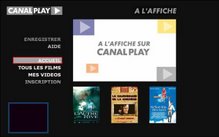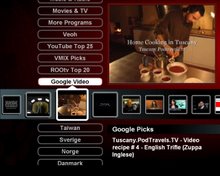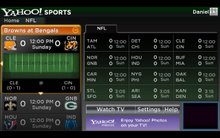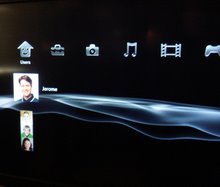Navigate YouTube available at iTunes App Sore
An easy to use iPhone and iPod touch App that enables both new and advanced YouTube users to get the best from YouTube.
Browse video Standard Feeds, Categories, Channels and Playlists. Then organize new videos into your own favorites and playlists. Make playlists private or public. Subscribe to other user's playlists and video collections for future viewing. Subscribe to videos matching search-words.
Look at publicly viewable favorite videos, playlists and subscriptions based on your YouTube friends, family and contacts. Send and receive video links with YouTube contacts via YouTube video messages.
Search for new videos tagged for your language or geographical region, using local keyboard. Explore for new videos via easy switching of user ID to the owner of interesting videos - then explore their world.
All actions are kept in sync with PC, Mac or Apple-TV access to YouTube. Available at Apple App Store.
Browse video Standard Feeds, Categories, Channels and Playlists. Then organize new videos into your own favorites and playlists. Make playlists private or public. Subscribe to other user's playlists and video collections for future viewing. Subscribe to videos matching search-words.
Search for new videos tagged for your language or geographical region, using local keyboard. Explore for new videos via easy switching of user ID to the owner of interesting videos - then explore their world.
All actions are kept in sync with PC, Mac or Apple-TV access to YouTube. Available at Apple App Store.
active-TV technology for PC

Windows PC based home network
Thursday, October 19, 2006
Sony Chief say Consumer Electronics dying!
Active-TV Ecosystem Developers,
A Sony adviser says: “people want to use the TV as a portal to the net”. I doubt he means the TV should display PC-web; more likely he means the TV should simply be connected via IP to the internet. He describes this as the “next stage” for convergence and the consumer electronics industry.
One solution is for a TV, or STB-like appliance, to support a standalone micro-browser using CE4HTML formatted TV-web – Sony and partners are developing this, along with other approaches. However, it is hard for the embedded microbowser approach to offer the same TV-web processing capability across lots of different hardware platforms. This difficulty would be less of a problem if TV-web does not incur the rapid developments seen in PC-web; such as new browser plug-ins and HTML extensions.
Reliance on active-TV style browser projection from and Extended-PC, limits the STB’s standalone ability to process more complex TV-web; but it does result in a common, consistent and powerful platform for processing TV-web formatted channels.
Feedback, corrections and comments welcome.
more at http://www.theinquirer.net/default.aspx?article=34943
A Sony adviser says: “people want to use the TV as a portal to the net”. I doubt he means the TV should display PC-web; more likely he means the TV should simply be connected via IP to the internet. He describes this as the “next stage” for convergence and the consumer electronics industry.
One solution is for a TV, or STB-like appliance, to support a standalone micro-browser using CE4HTML formatted TV-web – Sony and partners are developing this, along with other approaches. However, it is hard for the embedded microbowser approach to offer the same TV-web processing capability across lots of different hardware platforms. This difficulty would be less of a problem if TV-web does not incur the rapid developments seen in PC-web; such as new browser plug-ins and HTML extensions.
Reliance on active-TV style browser projection from and Extended-PC, limits the STB’s standalone ability to process more complex TV-web; but it does result in a common, consistent and powerful platform for processing TV-web formatted channels.
Feedback, corrections and comments welcome.
more at http://www.theinquirer.net/default.aspx?article=34943
Monday, October 16, 2006
Dell to offer AMD Live!
Active-TV Ecosystem Developers,
More confirmation in the linked material, below, that ViiV’s utility in support of digital convergence is not understood. The problem is hampered by Intel, and its collaborators, not introducing ecosystem clients able to gain consumer approval.
Intel ViiV does not have a simple consumer-message, such as adding TV-web to the already familiar STB.
As one Industry watcher put it: ” The PC Industry MBAs have so far, after many years of trying, not managed to manufacture consumer-consent for their convergence platforms. Their approach has not conformed with the fashionable term ‘consumer-led’, maybe not even technology-led, but there is clearly a significant element of corporate-ambition-led.”
Alternatively, the active-TV approach is not lead by the PC Industry alone, but is a combining of the best of the PC industry (Extended-PC) with the best of the STB (hybrid-STB) and established video entertainment platform industry. As well is equal involvement from TV-web channel developers and overlay TV-web formatted TV advertisers.
Feedback, corrections and comments welcome.
more at http://www.xbitlabs.com/news/multimedia/display/20061012083451.html
Dell Drops Intel Viiv in Favour of AMD Live!
What's a Viiv, and will you care come Christmas? Intel (INTC) sure hopes so.
more at http://businessweek.com/technology/content/oct2006/tc20061016_479218.htm?chan=top+news_top+news+index_technology
More confirmation in the linked material, below, that ViiV’s utility in support of digital convergence is not understood. The problem is hampered by Intel, and its collaborators, not introducing ecosystem clients able to gain consumer approval.
Intel ViiV does not have a simple consumer-message, such as adding TV-web to the already familiar STB.
As one Industry watcher put it: ” The PC Industry MBAs have so far, after many years of trying, not managed to manufacture consumer-consent for their convergence platforms. Their approach has not conformed with the fashionable term ‘consumer-led’, maybe not even technology-led, but there is clearly a significant element of corporate-ambition-led.”
Alternatively, the active-TV approach is not lead by the PC Industry alone, but is a combining of the best of the PC industry (Extended-PC) with the best of the STB (hybrid-STB) and established video entertainment platform industry. As well is equal involvement from TV-web channel developers and overlay TV-web formatted TV advertisers.
Feedback, corrections and comments welcome.
more at http://www.xbitlabs.com/news/multimedia/display/20061012083451.html
Dell Drops Intel Viiv in Favour of AMD Live!
What's a Viiv, and will you care come Christmas? Intel (INTC) sure hopes so.
more at http://businessweek.com/technology/content/oct2006/tc20061016_479218.htm?chan=top+news_top+news+index_technology
Tuesday, October 10, 2006
Yahoo Sports
Active-TV Ecosystem Developers,
Recently, Yahoo and Intel issued press releases regarding the Yahoo Sports TV-web channel. There is an extract below. Intel states it is “currently only available for PCs equipped with Intel Viiv technology”. Intel ViiV uses the Media Center Edition (MCE) version of Windows. However, using active-TV software, I had no problem accessing Yahoo Sport from an AMD-based Windows XP PC, or an active-TV Hybrid-STB.
Yahoo Sports’ first TV-web page includes the image “Enjoy with Intel ViiV”, see the screen shot below (lower right).

Yahoo Sports brings US Football statistics to the TV screen. Intel still requires a PC-in-living-room approach; As the ViiV thin-clients have still not appeared. I did not try accessing Yahoo Sports from an Extended Xbox360 – this should work.

Yahoo Sports does not use the overlay TV-web approach supported by active-TV. However a TV image can be scaled to fit within a region of the TV-web channel (known as a Spotlight in Microsoft-speak). Clearly, active-TV also supports this approach. The Intel ViiV method requires a PCI TV-tuner card be used by the PC. The TV channel is typically received in analogy NTSC format and encoded to WMV video. The TV screen shot below shows the TV area as a black rectangle as I was unable to capture the TV image.
Testing indicates the user must first tune to the correct TV channel before staring the Yahoo Sports TV-web channel. If some kind of Microsoft or ViiV Extender was used, the digitised TV video would be sent to the thin-client for presentation on the networked TV.

The active-TV approach in support of Yahoo Sports is different. There would be no use of a PCI TV tuner card. TV video would not be digitised by the PC and sent over the home network. A networked hybrid-STB would receive the broadcast TV in high-def ATSC format (DVB would be used in Europe). The Extended-Notebook (or PC) would process the TV-web material and send it over the network for merging by STB; to produce the TV image.
The active-TV approach requires a lot less network traffic. It also better supports High-Def TV viewing – there is no need to encode analog video, which always results in a reduction in image quality.
Using TV-web brings the TV channel and the statistical information to a single screen. An alternative is to use PC-web with a notebook located in the same room as the TV. But this does not bring the different “materials” to the same screen. Of course, the Notebook computer could also be used to project TV-web to the hybrid-STB while simultaneously supporting the PC-web site.
Feedback, corrections and comments welcome.
Recently, Yahoo and Intel issued press releases regarding the Yahoo Sports TV-web channel. There is an extract below. Intel states it is “currently only available for PCs equipped with Intel Viiv technology”. Intel ViiV uses the Media Center Edition (MCE) version of Windows. However, using active-TV software, I had no problem accessing Yahoo Sport from an AMD-based Windows XP PC, or an active-TV Hybrid-STB.
Yahoo Sports’ first TV-web page includes the image “Enjoy with Intel ViiV”, see the screen shot below (lower right).
Yahoo Sports brings US Football statistics to the TV screen. Intel still requires a PC-in-living-room approach; As the ViiV thin-clients have still not appeared. I did not try accessing Yahoo Sports from an Extended Xbox360 – this should work.
Yahoo Sports does not use the overlay TV-web approach supported by active-TV. However a TV image can be scaled to fit within a region of the TV-web channel (known as a Spotlight in Microsoft-speak). Clearly, active-TV also supports this approach. The Intel ViiV method requires a PCI TV-tuner card be used by the PC. The TV channel is typically received in analogy NTSC format and encoded to WMV video. The TV screen shot below shows the TV area as a black rectangle as I was unable to capture the TV image.
Testing indicates the user must first tune to the correct TV channel before staring the Yahoo Sports TV-web channel. If some kind of Microsoft or ViiV Extender was used, the digitised TV video would be sent to the thin-client for presentation on the networked TV.
The active-TV approach in support of Yahoo Sports is different. There would be no use of a PCI TV tuner card. TV video would not be digitised by the PC and sent over the home network. A networked hybrid-STB would receive the broadcast TV in high-def ATSC format (DVB would be used in Europe). The Extended-Notebook (or PC) would process the TV-web material and send it over the network for merging by STB; to produce the TV image.
The active-TV approach requires a lot less network traffic. It also better supports High-Def TV viewing – there is no need to encode analog video, which always results in a reduction in image quality.
Using TV-web brings the TV channel and the statistical information to a single screen. An alternative is to use PC-web with a notebook located in the same room as the TV. But this does not bring the different “materials” to the same screen. Of course, the Notebook computer could also be used to project TV-web to the hybrid-STB while simultaneously supporting the PC-web site.
Feedback, corrections and comments welcome.
more at http://www.intel.com/pressroom/archive/releases/20060913comp.htm
Tuesday, October 3, 2006
Red Bee Showcases IPTV i-Ad via active-TV
Active-TV Ecosystem Developers,
Linked below is a report on the overlay TV-web demonstration by Red Bee at IBC. The reporter summaries the terminology well with the expression: “the prototype was running on a Futarque set-top with AMD's ActiveTV software; the set-top was connected in turn to an Internet-connected AMDLive! PC”.
The active-TV approach uses the PC’s browser to process the TV-web material ultimately presented at the hybrid-STB’s TV. The method avoids many of the “technical constraints” limiting a STB acting alone.
TV advertising is a $60B business in the US. The business is changing due to new consumer technology (DVR and TCP-IP) and new consumer behaviour. The use of TV-web channels and overlay TV-web are technical- and cost-effective new solutions.
Much, or maybe most, of the PC industry has struggled to position the PC-in-the-living-room as the platform-solution to the changes occurring with TV entertainment. The focus has also been on using computer networking to deliver an IP-TV alternative source of Hollywood-type content. No matter that this material is already widely available from several existing distribution channels.
Consequently, there has been more discussion about DTCP-IP content protection than new forms of TV advertising. I suggest there has been too much focus on offering alternative platforms supporting familiar forms of content consumption – merely using a new IP distribution method. Of more importance is developing lower-cost platform-solutions which address the changing nature of consumer behaviour. I suggest, this line of thinking, makes overlay TV-web more interesting than TCP-IP content protection.
Linked is an interesting US study entitled “The New ‘Digital Divide’, How the New Generation of Digital Consumers are Transforming Mass Communication.” Although much of the study is about PC-web behaviour, there are clearly implications for TV audiences and TV advertising – particularly given the emergence of active-TV technology.
[quote from New Digital Divide linked below]
“There is no doubt that we are moving rapidly from a world of passive receptivity to active engagement. No longer can we simply broadcast our messages to a mass audience and hope that our standard metrics of reach and frequency will guarantee success. Accountable engagement innovation is the battlefield of the 21st century”
Comments, corrections and feedback welcome.
more at http://universalmccann.com/downloads/papers/The%20New%20Digital%20Divide.pdf
and http://blog.itvt.com/my_weblog/2006/09/red_bee_showcas.html
Linked below is a report on the overlay TV-web demonstration by Red Bee at IBC. The reporter summaries the terminology well with the expression: “the prototype was running on a Futarque set-top with AMD's ActiveTV software; the set-top was connected in turn to an Internet-connected AMDLive! PC”.
The active-TV approach uses the PC’s browser to process the TV-web material ultimately presented at the hybrid-STB’s TV. The method avoids many of the “technical constraints” limiting a STB acting alone.
TV advertising is a $60B business in the US. The business is changing due to new consumer technology (DVR and TCP-IP) and new consumer behaviour. The use of TV-web channels and overlay TV-web are technical- and cost-effective new solutions.
Much, or maybe most, of the PC industry has struggled to position the PC-in-the-living-room as the platform-solution to the changes occurring with TV entertainment. The focus has also been on using computer networking to deliver an IP-TV alternative source of Hollywood-type content. No matter that this material is already widely available from several existing distribution channels.
Consequently, there has been more discussion about DTCP-IP content protection than new forms of TV advertising. I suggest there has been too much focus on offering alternative platforms supporting familiar forms of content consumption – merely using a new IP distribution method. Of more importance is developing lower-cost platform-solutions which address the changing nature of consumer behaviour. I suggest, this line of thinking, makes overlay TV-web more interesting than TCP-IP content protection.
Linked is an interesting US study entitled “The New ‘Digital Divide’, How the New Generation of Digital Consumers are Transforming Mass Communication.” Although much of the study is about PC-web behaviour, there are clearly implications for TV audiences and TV advertising – particularly given the emergence of active-TV technology.
[quote from New Digital Divide linked below]
“There is no doubt that we are moving rapidly from a world of passive receptivity to active engagement. No longer can we simply broadcast our messages to a mass audience and hope that our standard metrics of reach and frequency will guarantee success. Accountable engagement innovation is the battlefield of the 21st century”
- The age group 16-34 is 25% more likely than ages 35-49 to use instant messenger, with over 75% of ages 16-34 currently using at least one service.
- About 40% age P16-34 belong to a social network site; this is twice the percentage of 35-49 year olds.
- 71% of the 16-34 year olds have participated in a blogging activity.
- One third of 16-34's have participated in peer-to-peer file sharing compared to just 12% of those 35-49. [end]
Comments, corrections and feedback welcome.
more at http://universalmccann.com/downloads/papers/The%20New%20Digital%20Divide.pdf
and http://blog.itvt.com/my_weblog/2006/09/red_bee_showcas.html
Labels:
advertising,
DTCP-IP,
Futarque,
interactive TV,
Red Bee
Subscribe to:
Posts (Atom)









